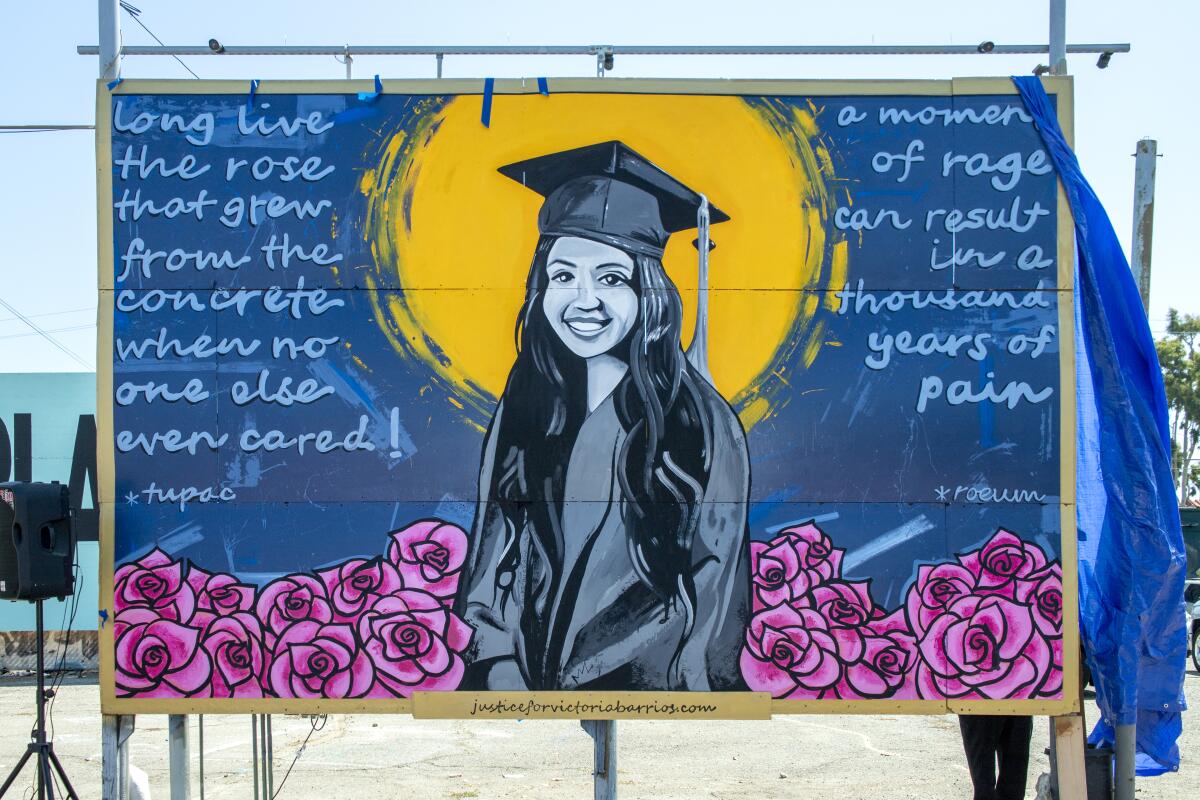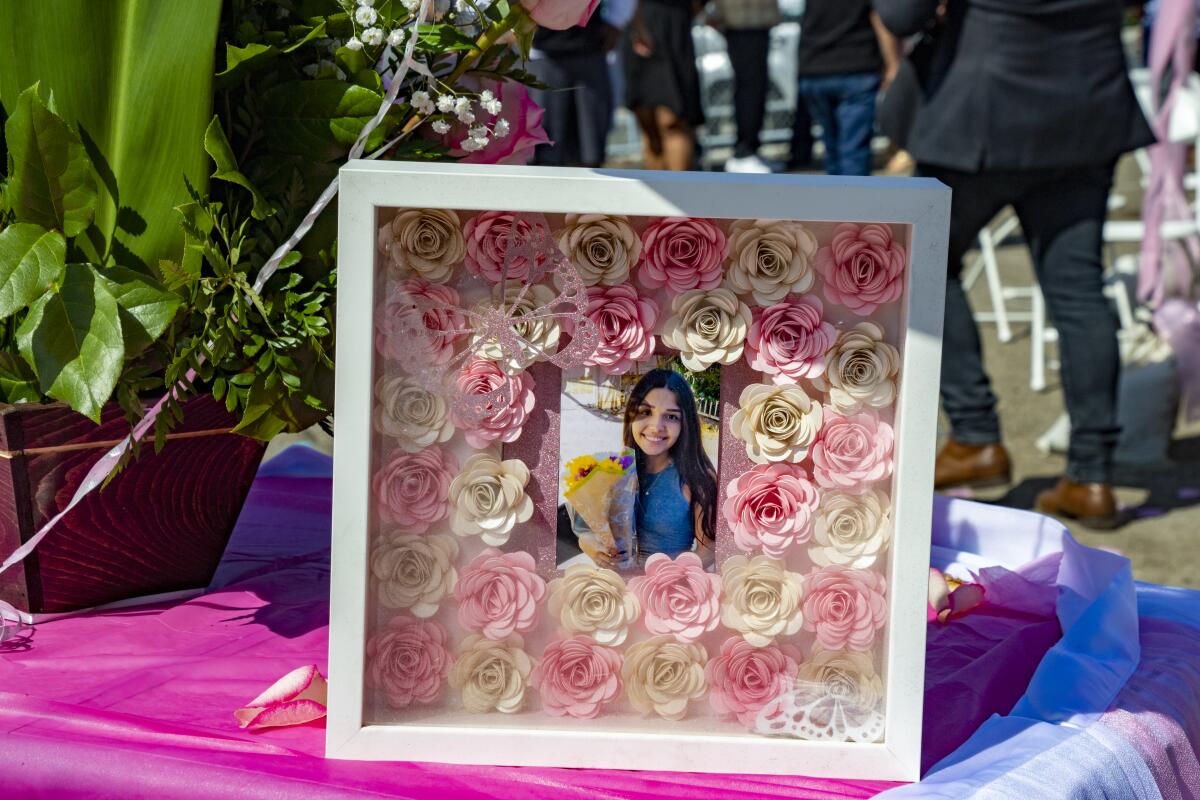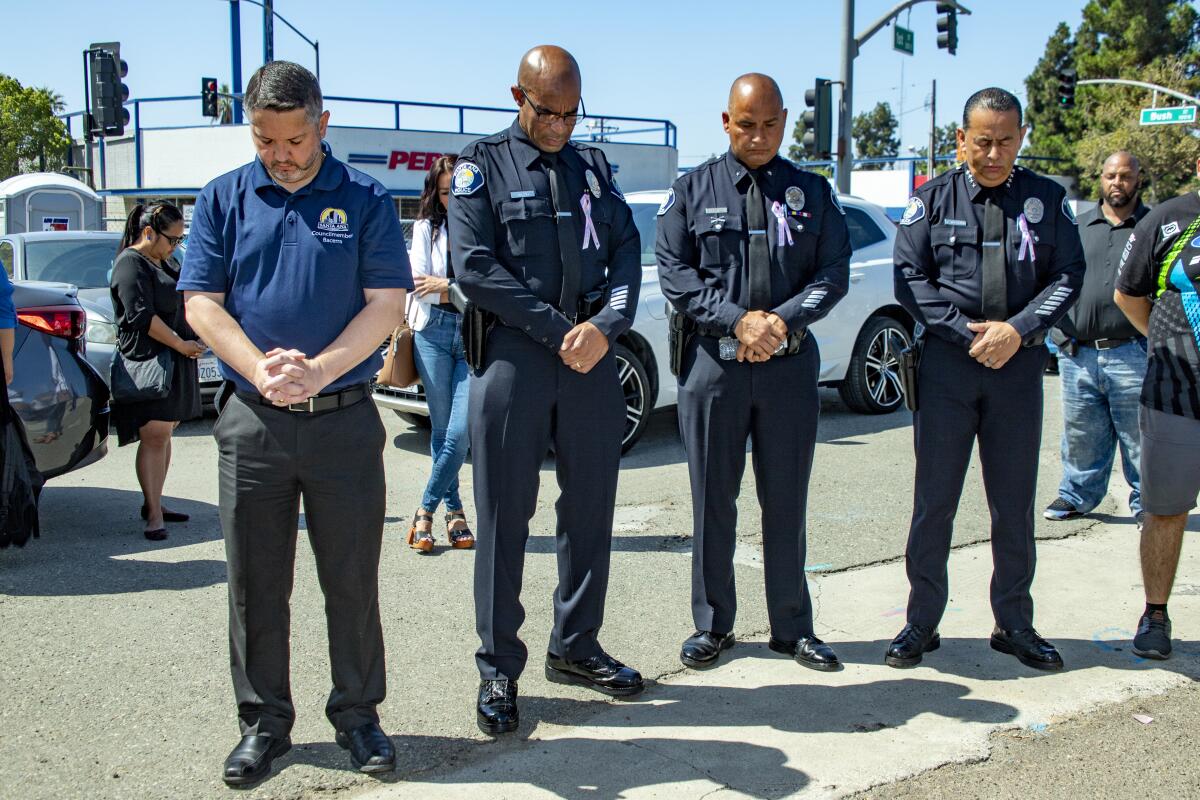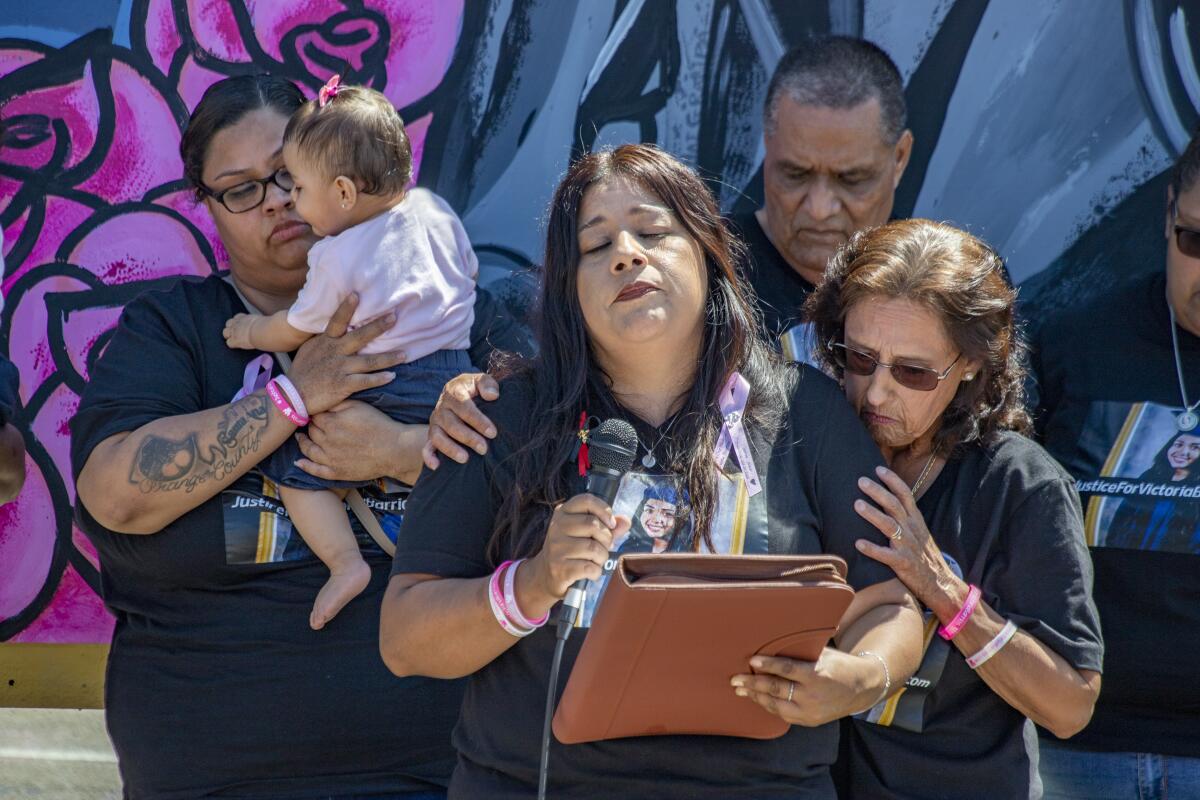‘Who killed my daughter?’: A Santa Ana mother seeks answers in her daughter’s murder

- Share via
“Who killed my daughter?”
That’s the question the family of Victoria Barrios has been trying to find an answer to since the 18-year-old was gunned down two years ago in a Santa Ana neighborhood.
It’s the question that Eva Barrios has put on billboards throughout the county as she seeks witnesses and information about her daughter’s killer.
It’s the question posed on the family’s website, which has amassed leads for investigators, though no arrests have been made in the case.
Eva hasn’t let her grief get the best of her. Her ongoing outreach efforts to try to find her daughter’s killer are uncommon and tenacious.
Last weekend, days before the anniversary of her death, the family unveiled a mural of Victoria in the Blue Lot in Santa Ana, a parking lot known for showcasing public art. The goal of the mural is to encourage more witnesses to come forward and to send a message to those who took part in the murder.
“I want them to drive around and say, ‘Oh, that’s the girl we killed,’” Eva said. “They’re not letting this go, because I’m not going to let it go. She’s not going to be just a statistic.”

In her early teenage years, Victoria waged a silent battle against depression and anxiety. For a long time, family didn’t know she had been suffering.
She eventually got on medication, which balanced her out. But in the months before the shooting, she stopped taking her medication and fell back into a rebellious stage.
Eva and her daughter ended up having a big fight after Victoria got a speeding ticket. She took her daughter’s car away, and Victoria ended up staying with friends the week of her murder. That was the last time Eva saw her daughter.
Victoria was with two of her friends when she was shot during a drive-by shooting just after midnight on Aug. 30, 2019, near 500 E. Pine St. Police found her with a gunshot wound to the upper torso. She was pronounced dead at the scene.
Homicide detectives found a video of the shooting, which showed that the perpetrator was inside a four-door, red Chevrolet car, possibly a Tahoe. There were multiple suspects in the vehicle, and the police consider the murder to be gang-related. The shooter fired the gun several times, and a man was also shot in the area.
Santa Ana Police Det. Matt McLeod, who is the lead on the Barrios case, said he couldn’t discuss specifics about it because it’s an active investigation.
McLeod said the main challenge has been overcoming people’s apprehension in providing information because many believe they can only do so in person. McLeod also said that in this case, like other investigations, potential witnesses or people who may have been involved in the crime may fear the repercussions of reporting information to the police.
“A lot of people are of the misunderstanding that in order to provide information for these types of cases, that you have to automatically go to court and stand up in front of the world and make a declared statement,” McLeod said. “Well, that’s far from the case. The main challenge is overcoming that misinformation ... Just because you’re providing information does not mean that you’re the chief and principal witness.”

McLeod said the police have been getting information “on a daily basis.”
When asked why the killer hasn’t been located despite getting regular information, McLeod responded: “When you deal with crimes of this extent, our duty as investigators, as police, is to make sure that ... every issue, every piece of evidence, is vetted, whether that be information coming by word of mouth, physical information or physical evidence,” McLeod said. “With that, it takes time because we are going, of course, to beyond a reasonable doubt, — that’s the standard that we hold ourselves to.
”... We’re dealing with such an egregious crime here, that we want to make absolutely sure, not just based upon hunches or information which could be at the end of the day ... proven inaccurate.”
When asked whether the police have any suspects, McLeod said the department is actively investigating leads on a few different persons of interest. He said that although much time has passed since the crime was committed, it won’t inhibit the investigation.
“From my experience having been assigned to the homicide detail here for an excess of 15 years, I’ve noticed actually that as time progresses, in certain instances, you will have an influx of information, due to the fact that people feel more comfortable providing that information,” McLeod said.
In the wake of the COVID-19 pandemic, the Children’s Bureau is offering a virtual way for Orange County residents to learn about becoming a foster or foster-adopt parent.
McLeod pointed out that the department has received information from the public, in large part, due to the public outreach efforts of the Barrios family.
“It’s generated response from the community, from even inside as well as outside Santa Ana,” McLeod said.
In the wake of her daughter’s death, Eva tried to think of ways to keep Victoria’s name out in the public after the initial media attention had died down. She was driving down the street when she saw an empty billboard. She contacted the billboard company, and the first billboard was put up posing the question to the public, “Who Killed My Daughter?” with contact info for the Santa Ana Police Department on it.
Eva then kept searching and connecting with billboard companies to get her daughter’s face up around the county.
For Eva, there’s anger at those who perpetrated the crime and frustration that the killer hasn’t been located. But there’s also the love and support the community has shown her and the family.
“My mind and body can’t comprehend it because I’m dying inside,” Eva said. “But I just have this great support and I have the community reaching out.”
Still, Eva is near certain that her daughter’s killer will be found. She is reassured by McLeod, who she calls “her detective.”
“He always tells me ‘when, not if,’” she said. “I have to believe in that.”

Victoria was a loved member of the community, kindhearted with an infectious laugh.
“She felt like she could conquer the world,” Eva said.
Felipe Guerrero, Victoria’s grandfather, said she was outgoing and lit up a room with her smile. She had a restless heart, never standing still, but also had an old soul, always caring for those in her life.
That carried over into her hopes for the future. Victoria hoped to be a police dispatcher or to enter into some other field that helped people.
Those dreams were kindled while watching crime shows with her granddad.
“She was amazed at how cool the dispatchers were — they wouldn’t panic,” Guerrero said, pointing out that she also was drawn to how the dispatchers could calm people down over the phone.
Guerrero said they are continuing to try and keep Victoria’s image and name out in the community so she doesn’t become a statistic. In fact, she’s become a symbol for the victims of the city’s long history of gang violence.
Earlier this year, Santa Ana Councilman Johnathan Hernandez got involved with Victoria’s family after realizing that Guerrero was her grandfather. Hernandez had known Guerrero for years due to their shared community work.
Hernandez grew up in a gang-ridden part of Santa Ana and his father was a well-known gang leader. For him, Victoria’s death touches him personally.
Hernandez has helped at-risk youth and gang members turn their lives around throughout his life through programs like his group Roses in the Concrete. With Victoria dying senselessly in a likely gang-related incident, Hernandez and the family decided to erect a mural of Victoria, drawing attention to the victims of gang violence in the city.
“She’s up there to represent the ones that should be here but are not,” Guerrero said of the mural.
Hernandez got in touch with his arts and culture commissioner, Fernando Olivares, to do the mural. Olivares is a well-known local artist with works publicly displayed in Santa Ana. When Hernandez introduced the artist to the Barrios family, he was immediately touched by Victoria’s story.
“It’s pretty tough, especially because I grew up in this neighborhood,” Olivares said. “Things happened to innocent people all the time.”
Olivares finished the mural in a week, the quickest he’s ever completed a public piece.
Using a common technique of his, Olivares hid little messages about Victoria throughout the mural. She was regularly called “Queen Victoria” by loved ones, so Olivares included a hidden crown at the bottom of the mural. He also included her date of birth in the sunbeams above her face.
“I asked them to give me a lot of phrases, words, numbers,” Olivares said. “I like to implement those things in the mural.”
One side of the mural contains the quote: “A moment of rage can result in a thousand years of pain.” Another side quotes Tupac Shakur: “Long live the rose that grew in concrete when no one else even cared.”

The Tupac reference is a favorite of Hernandez. While he said he marvels at the tenacity of a rose that grows from concrete — like the children who are determined enough to be successful despite growing up in poverty and violence — he believes it’s unsustainable.
“My intention is to bring justice to the Victoria Barrios family,” Hernandez said of the mural. “The only way we bring justice is we have to make people uncomfortable. And the reason why is because we pretend like this is normal. And for the first time we’re telling people, we see your pain and we understand that something here is very broken, and we are letting you know we’re committed to fixing it. That’s what that mural represents.
“It represents the acknowledgement that we can’t keep growing roses in concrete. We can’t just expect kids to make it by a hair. If you make it in this city, you’re not coming out unscathed, you’re coming out damaged. You’re coming out missing a couple petals, you’re going to come out tilting a little to the left.”
Hernandez said Santa Ana’s response to gangs has generally been hyperpolicing and gang injunctions. But he says he’s working to fix the problem at a community level. In addition to Hernandez, Mayor Vicente Sarmiento, and council members Jessie Lopez and Phil Bacerra showed up to the mural unveiling.
“Clearly, those reactions were not conducive to ending gangs,” Hernandez said. “The only way you’re going to end gangs is you have to have former gang members and people that have lived that life, work on the ground as interventionists. You have to create a response to generational gang-banging. You have to prevent kids from ever getting to the point where they consider destroying themselves. You have to have mental health. You have to have equitable housing. You have to have sports programs. You have to have music programs. You have to have cultural celebrations.”
Hernandez said he recently created the Gang Reduction Youth Development Department, which will contract with different organizations that will work on the ground, including the Santa Ana-based Neutral Ground, which is made up of “justice-impacted individuals.” Hernandez was able to secure about $2 million worth of funding to devote towards the program.
“There’s so much that goes into this, we are just now getting started,” Hernandez said.
Hernandez said that gang culture is protecting Victoria’s killer.
“It’s because of gang culture that you’re not able to come forward,” Hernandez said. “... Gang culture is protecting this guy. It’s not snitching, this guy killed an 18-year-old little girl. What are you protecting?”

On Saturday morning in a quiet heat, Bertha Tillman’s “Oh my Angel” played over a loudspeaker in a Santa Ana parking lot as Eva stared up at a mural of her late daughter.
That infectious smile of Victoria’s. Her kind eyes.
As the tears came, loved ones crowded around Eva.
Usually when a mural is unveiled, it’s met with applause. But all were silent as the mural of Victoria Barrios was revealed.
Friends, family, and community members gazed deeply at the mural.
The music played.
Tillman sang: “Oh, my angel, come back to me.”
All the latest on Orange County from Orange County.
Get our free TimesOC newsletter.
You may occasionally receive promotional content from the Daily Pilot.




